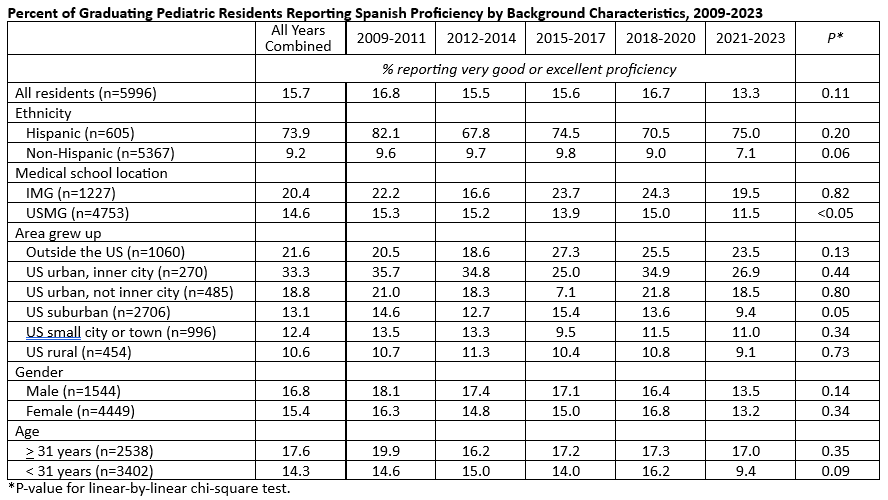Medical Education 6: Health Equity
Session: Medical Education 6: Health Equity
450 - Spanish Proficiency Among US Graduating Pediatric Residents: 2009–2023
Saturday, April 26, 2025
2:30pm - 4:45pm HST
Publication Number: 450.6720
Elizabeth A. Gottschlich, American Academy of Pediatrics, Itasca, IL, United States; Tylar Kist, American Academy of Pediatrics, Itasca, IL, United States; Melissa S. Stockwell, Columbia University Vagelos College of Physicians and Surgeons, New York, NY, United States
- EG
Elizabeth A. Gottschlich, MA (she/her/hers)
Senior Research Associate
American Academy of Pediatrics
Itasca, Illinois, United States
Presenting Author(s)
Background: An increasing proportion of US children are identified as Hispanic. Among families who speak a language other than English at home, Spanish is most common. However, trend data on new pediatricians’ Spanish language skills are lacking.
Objective: Describe trends in the proportion of graduating pediatric residents who self-report Spanish proficiency from 2009 to 2023 and examine trends by resident background characteristics.
Design/Methods: The AAP Annual Survey of Graduating Residents was sent to national random samples of 1000-1200 US pediatric residency graduates from 2009-2023 (11 total surveys; n=5996). Response rates ranged from 64% (2012) to 38% (2021). Residents rated their level of proficiency with the Spanish language (poor, fair, good, very good, excellent). Cross-sectional responses were pooled into survey year groups (2009-2011, 2012-2014, 2015-2017, 2018-2020, 2021-2023). Chi-square linear-by-linear association examined self-rated proficiency (very good or excellent) across survey year groups overall and by background characteristics: ethnicity (Hispanic, non-Hispanic); medical school location (international–IMG, US–USMG); area grew up (outside the US, US urban inner city, US urban not inner city, US suburban, US small city or town, US rural); gender (male, female); and age (mean split: 31 years or older, < 31 years). Based on prior work, we also derived and examined a variable that combines ethnicity and medical school location (Hispanic USMG, non-Hispanic USMG, Hispanic IMG, non-Hispanic IMG).
Results: Across the 15-year study period, 15.7% of residents reported Spanish proficiency overall, with no significant time change (16.8% in 2009-2011 to 13.3% in 2021-2023, p=0.11; Table). When examining trends by background characteristics, proficiency decreased slightly for USMGs but neither increased nor decreased for all other groups (Table). For proficiency trends by ethnicity and medical school location combined, we found a slight decrease among USMGs who self-identified as non-Hispanic (10.8% in 2009-11 to 7.8% in 2021-2023, p< 0.05; Figure). Notably, while 10.1% of all residents identified as Hispanic, these residents represented nearly half (47.5%) of those who reported proficiency in Spanish.
Conclusion(s): Between 2009 and 2023, less than 1 in 6 graduating pediatric residents reported Spanish proficiency, and the proportion has not grown over time. Given the increasing population of Hispanic children in the US, our findings highlight a potential concerning trend in pediatric workforce preparedness.
Table: Percent of Graduating Pediatric Residents Reporting Spanish Proficiency by Background Characteristics, 2009-2023

Figure: Percent of Graduating Pediatric Residents Reporting Spanish Proficiency (Very Good or Excellent) by Ethnicity and Medical School Location, 2009-2023
.png)

